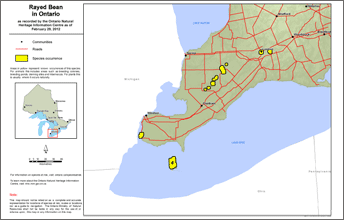Rayed bean
Scientific name: Villosa fabalis

Cover photo credit: Photo Field Guide to the Freshwater Mussels of Ontario
Status
Endangered
“Endangered” means the species lives in the wild in Ontario but is facing imminent extinction or extirpation.
Read the Assessment Report
Date added to the Species at Risk in Ontario List
The Rayed bean was already assessed as Endangered when the Endangered Species Act took effect in 2008.
What it looks like
The Rayed bean is one of Canada’s smallest freshwater mussels, reaching less than four centimetres in length.
The shell is oval-shaped, smooth, slightly shiny, and is green, yellow-green, or brown in colour with numerous wavy dark green lines.
Where it lives
The Rayed bean is typically found buried in sand or gravel in shallow, clear headwaters and riffle areas of small tributaries.
It is often found buried among the roots of aquatic plants.
The Rayed bean filters water to find food, such as bacteria and algae.
Mussel larvae are parasitic and must attach to a fish host, where they consume nutrients from the fish body until they transform into juvenile mussels and drop off.
Where it’s been found in Ontario
Canada, the Rayed bean is found only in southern Ontario, in the East Sydenham River and a small section of the North Thames River.
The species has been lost from Lake Erie and the Detroit River.
In Ontario, the fish hosts of the Rayed bean include: the Brook Stickleback, Largemouth Bass, Greenside Darter, Johnny Darter, Rainbow Darter, Logperch, and Mottled Sculpin.
The presence of fish hosts is one of the key features for an area to support a healthy mussel population.
View a Larger version of this map (PDF)
What threatens it
The greatest threats to the Rayed bean are invasive species, pollution and siltation, which occurs when too much soil washes into the river from nearby agricultural and urban areas.
The Zebra mussel, an invasive species from Europe, is a serious concern because it attaches to native mussels and can interfere with breathing, feeding, excretion, and movement.
Conditions that threaten the fish hosts also threaten the Rayed bean.
Action we are taking
Endangered Species and their general habitat are automatically protected
Recovery strategy
A recovery strategy advises the ministry on ways to ensure healthy numbers of the species return to Ontario.
Read the executive summary (September 10, 2010)
Read the recovery strategy (September 10, 2010)
Government response statement
A government response statement outlines the actions the government intends to take or support to help recover the species.
Read the government response statement (June 15, 2011)
Five-Year Review of Progress
A five-year review reports on progress made toward protecting and recovering a species, within five years of publishing a species’ government response statement.
Read the report on progress towards the protection and recovery of 27 species at risk, including Rayed Bean (2016).
Habitat protection
General Habitat Protection - June 30, 2013
What you can do
Report a sighting
Report a sighting of an endangered animal or plant to the Natural Heritage Information Centre. Photographs with specific locations or mapping coordinates are always helpful.
Volunteer
Volunteer with your local nature club or provincial park to participate in surveys or stewardship work focused on species at risk.
Be a good steward
- private land owners have a very important role to play in species recovery; if you find Rayed bean in a watercourse on or adjacent to your property, you may be eligible for stewardship programs that support the protection and recovery of species at risk and their habitats
- invasive species seriously threaten many of Ontario’s species at risk; to learn what you can do to help reduce the threat of invasive species, visit:
- farmers and land owners can help improve mussel habitat and keep Ontario’s water safe and clean by maintaining natural vegetation next to creeks and rivers, and keeping pollution and soil from washing into Ontario’s streams and rivers; for more information about programs and funding assistance for eligible land owners visit the Ontario Soil and Crop Improvement Association website
Report illegal activity
Report any illegal activity related to plants and wildlife to
Quick facts
- the Rayed bean is extremely rare throughout its range; it is known from fewer than 25 river systems in Canada and the United States
- Rayed bean eggs hatch inside a special pouch in the mother’s gills called a marsupium; here, the larvae are supported until they are ejected with a strong blast of water
- mussels are indicators of environmental health; since they have a complex life cycle, are long-lived (some species can live up to 100 years) and eat by filtering water and its pollutants, mussels can provide a snapshot of how healthy our waterways are
- aboriginal people harvested mussels for food and to create jewelry and tools; in the 1800s, massive numbers of mussels were harvested from the Grand River to create buttons; millions were shipped out every year until the 1940s when plastic became more popular
